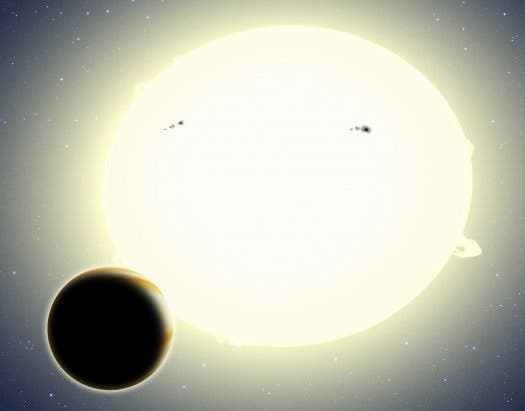
A new alien planet has been found by astronomers who have a novel planet hunting method which makes good use of Einstein’s special theory of relativity. The newly found exoplanet is slightly larger than Jupiter and is the first such planet found with this method.
The planet orbits a star in the constellation Cygnus, about 2,000 light-years away from Earth. It’s about 25 percent larger than Jupiter in diameter and twice as massive. In honor of the scientists who first described general relativity, the planet has been nicknamed “Einstein’s planet” by the team of international astronomers that discovered it. Officially, it’s name is Kepler-76b, signifying the ever resourceful Kepler space telescope was used for observations, but on that in just a few moments.
Typically, astronomers make use of the transient method to discover other worlds beyond our solar system, which consists of looking for faint blips in the brightness of a parent star. If stars dim periodically, it means that in the observational plane between the observer (Kepler) and the star, an object (exoplanet) must be orbiting around the star. Primarily using this method, some 800 planets have discovered, some of which are considered Earth-like, both in terms of size and potential for supporting life.
The new method capitalizes on Einstein’s theory of special relativity to find the planet. The star brightens when the planet moves toward Earth, tugging the star with it because of gravitational tides. Relativistic effects focus the star’s light. This causes it to appear brighter when its wider side faces us, revealing more surface area, and dimmer when it moves away from Earth. Additionally, the planet reflects starlight off it, contributing further to the discovery.
The method is appealing for wider use since it can be employed to find planets that can’t be observed otherwise using other methods, like the transient or wobbly methods. You don’t need Kepler, Earth and the parent star to be perfectly aligned in order to detect planets and high-precision measurements of a star’s velocity aren’t required anymore. It’s not without shortcomings either. The method requires extremely detailed observations to work and is only reliable for hunting large planets, not Earth-sized. Luckily, exquisite data NASA is collecting with the Kepler spacecraft is detailed enough for the relativistic method to render results.
“We are looking for very subtle effects,” said team member David Latham of the Harvard-Smithsonian Center for Astrophysics in Cambridge, Mass. “We needed high quality measurements of stellar brightnesses, accurate to a few parts per million.”
When combined with other methods, however, the new method, whose acronym is BEER (BEaming effect with Ellipsoidal and Reflection/emission modulations), can complement the advantages of different techniques.


